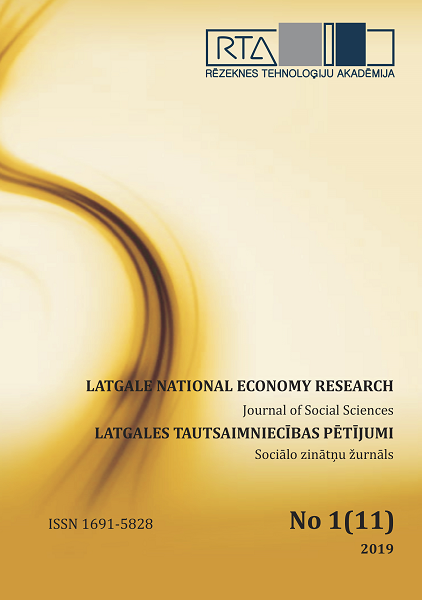ASSESSMENT OF THE ECONOMIC EFFECTIVENESS OF THE USE OF FINANCIAL RESOURCES FOR TRAINING OF THE UNEMPLOYED
DOI:
https://doi.org/10.17770/lner2019vol1.11.4362Keywords:
training programmes, the unemployed, finding employment, financial resources, State Employment AgencyAbstract
Along with the rapid development of technologies, demand on the labor market changes, still the skills and knowledge of jobseekers do not match the market needs. The State Employment Agency (hereinafter – SEA) implements training measures for the unemployed. Nevertheless, there is a problem that the unemployed involved in training do not always want to enter the labour market, or their knowledge acquired during the training is not useful. The aim of the study is to assess the economic efficiency of the financial resources allocated for training of the unemployed persons in the context of Latvia and its regions. Research methods: monographic method, graphical method, expert survey method, correlation and regression analysis. The authors explore the use of the financial resources allocated for training and analyse its economic efficiency in Latvia and Latvia's regions. It is found that the difference in unemployment rates in the statistical regions of Latvia has significantly increased during the study period. In order to facilitate the reintegration of individuals into the labour market, more funding is provided for training in the regions with higher unemployment rates. The economic efficiency of the use of financial resources varies from region to region, both in terms of the cost of training per unemployed person involved and the number of the trainees employed after the training, and of the funding for training used in the region.
References
Aysina, R. M., Maksimenko Z. A., Nikiforov, M. V. (2016). Feasibility and Efficacy of Job interview Simulation Training for long-term Unemployed Individuāls PsychNology Journal, 14 (1), 41-60.
Arifi, A., Marmullaku, B. (2019). Youth Labor Market Transition Challenges in Western Balkans: the case of Macedonia, Serbia and Montenegro. European Scientific Journal, 15 (5), 154-162.
Barbare, I. (2013). Nodarbinātības valsts aģentūras apmācību pasākumu atbilstība Latvijas darba tirgus vajadzībām. Starptautiskās zinātniskās konferences materiāli. Sabiedrība. Integrācija. Izglītība, 2, 291-301.
Bratti, M., Ghirelli, C., Havari, E., Santangelo, G. (2018). Vocational Training for Unemployed Youth in Latvia: Evidence from a Regression Discontinuity Design. IZA Institute of Labor Economics, Discussion Paper Series IZA DP, 11870. Retrieved from http://ftp.iza.org/dp11870.pdf
Feracci, M., Fougere, D., Rain, A. (2017). The Impact of Training Programs Content on Unemployment Duration In France. 66TH Annual Congress of the French Economic Association. Retrieved from https://afse2017.sciencesconf.org/141483/document
Garcia, J.R. (2011). Youth Unemployment in Spain: Causes and Solutions. BBVA reseach. Retrieved from https://www.bbvaresearch.com/KETD/fbin/mult/WP_1131_tcm348-270325.pdf
Griņeviča, L. (2016). Jauniešu bezdarba ietekmējošo faktoru analīze Latvijā, promocijas darba kopsavilkums. Pieejas veids: http://llufb.llu.lv/dissertation-summary/regional-economics/LivaGrinevica_prom_darba_kopsav2016_ LLU_ESAF.pdf
Hazans, M. (2005). Unemployment and the Earnings Structure in Latvia. World Bank. Retrieved from https://elibrary.worldbank.org/doi/abs/10.1596/1813-9450-3504
Hodzic, S., Ripoll, P., Bernal, C. (2015). The Effect of Emotional Competences Training Among Unemployed Adults: Longitudinal Study. Applied psychology: Health and Well - Being, 7 (3). p. 275-292.
Laskova, J., Brokane, L. (2014). Opportunities and motivation for training unemployed in Latvia. 5th World Conference on Education Sciences – WCES, Procedia – Social and Behavioral Science, 116, 649-655.
Laškova, J. (2012). Bezdarbnieku izglītošanas iespējas Latvijā. Starptautiskās zinātniskās konferences materiāli. Sabiedrība. Integrācija. Izglītība, 1, 503-514.
Latvijas Nacionālais attīstības plāns 2014.-2020. (2012). Latvijas Republikas Saeima. Pieejas veids: https://www.pkc.gov.lv/sites/default/files/inline-files/20121220_ NAP2020%20apstiprinats%20Saeima_4.pdf
Latvijas Republikas Centrālā statistikas pārvalde (CSB) (2019). Bezdarba līmenis pēc tautības un dzimuma. Pieejas veids: http://data1.csb.gov.lv/pxweb/lv/ sociala/sociala__nodarb__bezdarbs__ikgad/NBG022.px/table/tableViewLayout1/?rxid=a39c3f49-e95e-43e7-b4f0-dce111b48ba1
Latvijas Republikas Labklājības ministrija (MoW) (2017). Par darba tirgus īstermiņa prognozēm 2017. gadam un bezdarbnieku un darba meklētāju prioritārajiem apmācību virzieniem. Pieejas veids: http://www.lm.gov.lv/upload/darba_tirgus/ a/lmzino_19052017.pdf
Latvijas Republikas Labklājības ministrija (MoW) (2016). Par darba tirgus īstermiņa prognozēm 2016. gadam un bezdarbnieku un darba meklētāju prioritārajiem apmācību virzieniem. Pieejas veids: http://www.lm.gov.lv/upload/darba_tirgus/ lmzino_2016_31032016.pdf
Latvijas Republikas Labklājības ministrija (MoW) (2018). Par bezdarbnieku un darba meklētāju apmācību rezultātiem 2017. gadā un prioritārajiem apmācību virzieniem. Pieejas veids: http://www.lm.gov.lv/upload/darba_tirgus/a/lmzino_2018.pdf
Lechner, M., Wunsch, C. (2009). Are Training Programs More Effective When Unemployment Is High? Journal of Labor Economics, 27 (4), 653-692.
Niklass, M. (2013). Jauniešu ar zemu izglītību iekļaušanās darba tirgū Latvijā, promocijas darbs. Pieejas veids: https://www.szf.lu.lv/fileadmin/user_upload/szf_ faili/Petnieciba/promocijas_darbi/Mareks%20Niklass_2013.pdf
Nodarbinātības valsts aģentūra (SEA) (2019). ESF projekta „Atbalsts bezdarbnieku izglītībai” Informācija par uzsāktajām dalībām no projekta sākuma līdz 31.12.2018(profesionālā apmācība, neformālā izglītība, praktiskā apmācība pie darba devēja).[NVA iekšējie statistikas dati].
Nodarbinātības valsts aģentūra (SEA) (2019a). Pārskats par bezdarba situāciju valstī (decembris). Pieejas veids: http://www.nva.gov.lv/docs/31_5c5066faa142f5. 77210853.pdf
Nodarbinātības valsts aģentūra (SEA) (2019b). ESF projekti (2014.-2020. gads). Pieejas veids: http://www.nva.gov.lv/index.php?cid=2&mid=511
Nodarbinātības valsts aģentūra (SEA) (2019c). Statistika. Pieejas veids: http://www.nva.gov.lv/index.php?cid=6
OECD (2017). Economic Surveys: Latvia. OECD Publishing. Retrieved from http://www.oecd.org/economy/surveys/Latvia-2017-OECD-economic-survey-overview.pdf.
Schonauer, C. (2016). Economic and Social Factors Influence on Unemployment in Romania at the Local Level. Computational methods in Social sciences, 4 (2), 54-59.
Sfichi, E., D., Bratiloveanu, A. (2017). Correlations between Labor Employment and Economic Growth „Ovidius” University Annals. Economic Sciences Series. 17 (1), 242-247.
Stalidzāne, G. (2015). Career Development Theories for the Education of Unemployed. Proceedings of the Internetional Scientific Conference. Society. Integration. Education, 4, 224-232.
Vilka, L., Pelse, I. (2012). Deficiency of Employability Capacity. SHS Web of Conference 2. Retrieved fom https://www.shs-conferences.org/articles/shsconf/ pdf/2012/02/shsconf_shw2010_00039.pdf


